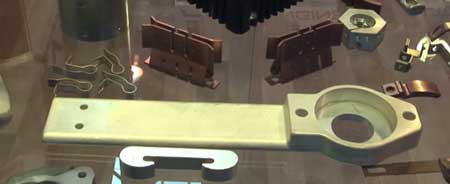
Busbars made of copper are commonplace in the world of electrical power distribution. Switchgear, panel boards and busways all use busbars to convey substantial amounts of electricity, allowing more flexibility for circuits to branch off.
Copper is more resistant to rust and corrosion and so is commonly used in the production of busbars and other electrical equipment.
However, copper does oxidise over time and because of this the resistance in the conductive metal will increase, meaning that more power is needed to carry any current along its surface. Beyond a certain point, the metal can begin to flake and fall apart. It is for this reason that many metals are plated – it helps them retain their positive qualities and attributes.
When it comes to copper busbars, plating plays an important part in the longevity of the busbar as well as maintaining the integrity of the conductive surface. When copper bus bars are not plated, over time the surface will oxidise and will not conduct as well as a smooth or plated surface. This results in more power being needed to push electricity along the surface.
Plating a busbar using tin or silver provides a coating over the surface of the copper, helping to protect against oxidisation. This will not completely prevent oxidising over long periods of time, but it can help to dramatically reduce the effects.
Tin and silver are the most common metals used for plating due to the fact that they are considered ‘soft metals’ and so are easier to work with. More importantly however, is the fact they do not offer large amounts of resistance to electrical conductivity.
So which is better? Silver or tin?
There are differing points of view throughout the industry. Tin can outperform silver, although it does take 10 times more tin to do the same job as silver. However, the price of silver in comparison to tin, means that even though it takes much more tin to do the same job, it’s often still more economical to use than silver.
When using silver to plate a copper busbar, a minimum of 3 microns should be used, although 6 microns is preferable. In addition an anti-tarnish needs to be applied to protect the finish. In most fixed bus bar applications, it is recommended to use tin plating. Silver should be used for moving busbar parts where arcing may be a concern.
Whether you use silver or tin for plating, anti-tarnish is important to keep the surface clean and conductive, ultimately ensuring the longevity and safety of the equipment.
PRV Engineering has been supplying the industry with quality busbars, conductors, contacts and connectors for many years
Whether you’re an International manufacturer of medium or high voltage distribution and transit switchgear, or an independent engineering contractor specialising in the maintenance, installation, testing of low voltage, high voltage and extra high voltage electrical plant and equipment PRV understands and can meet your needs.
Get in touch if you need advice or want a quote.
This site uses Akismet to reduce spam. Learn how your comment data is processed.


 Mail:
Mail: 




Leave a Comments